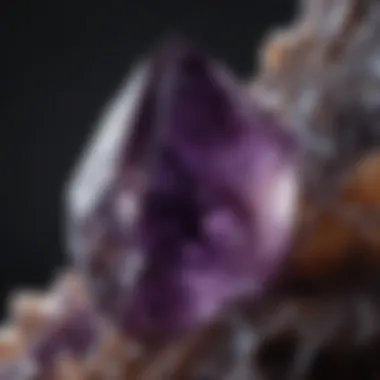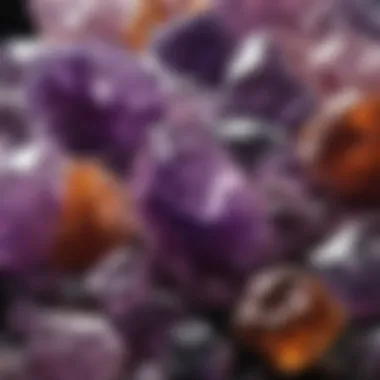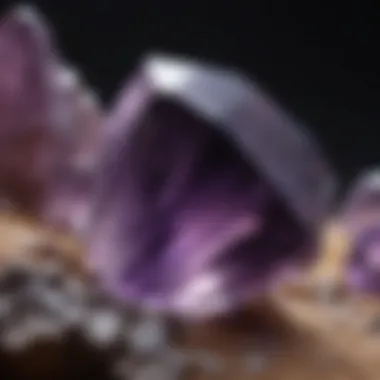How to Tell if an Amethyst Crystal is Real


Intro
Amethyst, a variety of quartz, holds a notable place in both jewelry and the world of collectible minerals. This purple gemstone, revered for its striking hues and purported metaphysical properties, appeals not only to collectors but also to wellness enthusiasts. However, with the rise in popularity of this crystal, the market has seen an influx of imitations and synthetics. As such, it becomes paramount for collectors to possess the knowledge necessary to discern genuine amethyst from replicas.
In this guide, we explore the essential characteristics that define authentic amethyst crystals. We delve into aspects like color, clarity, and the geological formation of amethyst. Additionally, we examine the significance of authenticity in the collecting community and provide practical strategies for identification. By gaining insight into these factors, enthusiasts can make informed decisions and appreciate the true value of amethyst.
Understanding Amethyst Crystals
Understanding amethyst crystals is essential for anyone involved in collecting or studying gemstones. This section will explore the core aspects of amethyst, offering insights into its nature, formation, and historical significance. Recognizing these elements can greatly benefit enthusiasts in both their purchasing decisions and their appreciation of this beautiful mineral.
What is Amethyst?
Amethyst is a purple variety of quartz, specifically composed of silicon dioxide. The coloration arises mainly from the presence of iron impurities and natural radiation. This stone has found its place not only in the realm of jewelry but also in crystal healing and various cultural practices. Amethyst is renowned for its calming properties, believed to aid in reducing stress and promoting peace of mind. For collectors, understanding the true nature of amethyst helps in discerning authentic pieces from imitations.
Geological Formation of Amethyst
Amethyst forms in igneous and metamorphic rocks through a combination of geological processes. It typically develops in gas cavities of rocks, where silica-rich fluids cool and crystallize over time. The formation process requires specific conditions, including a temperature range of 350-500 degrees Celsius. Significant deposits of amethyst are found in Brazil, Uruguay, and Zambia, among other locations. Knowledge of these geological factors is crucial for collectors to assess the authenticity and origin of their amethyst specimens.
Cultural Significance and Uses
From ancient civilizations to modern times, amethyst has held considerable cultural relevance. The Ancient Greeks believed that amethyst could prevent intoxication. In the Middle Ages, it was worn by clergy to symbolize purity and chastity. Today, amethyst continues to be popular in various forms, such as jewelry and decorative objects. Beyond aesthetics, it is employed in alternative therapies, attributed to promoting calmness and spiritual awareness. Recognizing its rich history can deepen a collector's appreciation for the stone and its various applications.
Visual Characteristics of Real Amethyst
Understanding the visual characteristics of real amethyst is crucial for enthusiasts and collectors. The way a crystal looks can tell a lot about its authenticity. Recognizing the distinct properties of amethyst helps prevent the acquisition of imitations, which could undermine the value of a collection. This section delves into the essential elements of color, clarity, and inclusions, providing a clear framework for identifying genuine amethyst.
Color Variations in Amethyst
Amethyst crystals are widely known for their striking colors, which can range from light lavender to deep purple. The depth of the color is often a primary indicator of quality and authenticity. A genuine amethyst displays a rich hue that is often consistent throughout the stone, without any uneven patches of color.
When assessing color, collectors should consider the saturation and tone. The best examples of amethyst have a deep, vivid purple that embodies a warm glow. Color zoning, where different shades appear in one crystal, is common. But excessive zoning may suggest that the stone is artificially treated or dyed. Natural amethyst maintains a balance in saturation; if the hues appear too vibrant or uniform, it might be cause for skepticism.
Clarity and Transparency Criteria
Clarity is another vital aspect of genuine amethyst. While some inclusions can add character to a crystal, an authentic amethyst should generally exhibit a good level of transparency. When looking through a piece of amethyst, it should be clear enough to see distinct outlines of objects placed behind it.
However, perfect clarity is rare in natural gemstones. Authentic amethyst may contain minor inclusions or internal features. These inclusions can serve as evidence of authenticity. As a collector, it is essential to distinguish between natural inclusions and man-made flaws. If the crystal appears too flawless, it may suggest synthetic origin or enhancements, undermining its value.
Identifying Inclusions
Inclusions are internal characteristics that can be found within a crystal. They vary in type and can provide insight into the crystal’s natural formation. For amethyst, common inclusions include tiny bubbles, cloud-like formations, and other mineral traces.


To identify these inclusions, hold the amethyst up to the light or use a loupe for a closer examination. Real amethyst often contains inclusions that are not uniformly distributed. If a piece is completely clear without a single inclusion, it likely indicates a synthetic stone; thus, genuine amethyst should exhibit some degree of imperfection.
Inclusions are generally accepted as unique identifiers for genuine amethyst, often adding to its story and value.
Physical Properties to Consider
Understanding the physical properties of amethyst is crucial for anyone looking to identify whether a specimen is genuine or not. Real amethyst possesses distinct characteristics that set it apart from imitations. This section focuses on three main aspects: hardness, specific gravity, and heat resistance. Each of these properties plays a vital role in evaluating the authenticity and overall quality of amethyst crystals.
Hardness and Durability
Amethyst ranks 7 on the Mohs scale of mineral hardness. This level of hardness indicates that amethyst is relatively durable compared to softer stones. Durability is essential for collectors who plan to wear or display the crystals. Soft stones can scratch easily, while hard stones tend to maintain their beauty through regular use.
When assessing hardness, collectors can gently tap the crystal against a known hard surface, like quartz or glass. If the amethyst shows signs of scratching or damage, it may not be authentic.
Specific Gravity Testing
Specific gravity refers to the density of the mineral compared to water. Real amethyst has a specific gravity of about 2.65. This property can be measured through simple methods, such as the water displacement technique. By weighing the crystal in air and then submerged in water, one can obtain the necessary values to calculate its specific gravity. If the result significantly deviates from the standard, it may indicate a fake stone.
"Specific gravity provides a quantitative measure that helps in verifying the authenticity of gemstones."
Heat Resistance of Amethyst
Heat resistance is another property worth considering. Authentic amethyst can withstand moderate heat. However, when exposed to extreme temperatures, genuine amethyst may change color or sustain damage. To test heat resistance, one method involves exposing the crystal to a heat source briefly and observing any reactions.
If the color of the amethyst fades or changes dramatically, it could signify that the stone is either treated or not genuine.
By examining these physical properties—hardness, specific gravity, and heat resistance—collectors can better determine the authenticity of amethyst crystals in their collections.
Chemical Composition of Amethyst
Understanding the chemical composition of amethyst is crucial in determining its authenticity. Amethyst is primarily composed of silicon dioxide, common among quartz varieties. It contains trace amounts of iron, which significantly influences its purple hue, making the study of its chemical structure not just interesting, but essential for collectors.
Understanding Quartz Structure
Amethyst is a variety of quartz, which means its base chemical structure is silicon dioxide (SiO₂). Quartz crystals form in a trigonal crystal system, typically exhibiting a hexagonal shape. The arrangement of silicon-oxygen tetrahedra within the crystal lattice contributes to the strength and clarity of the stone. The presence of impurities or defects in this structure can lead to varied coloration and clarity, which further helps in identifying genuine amethyst.
The substitution of silicon by other elements can happen, but it primarily retains its quartz structure. In amethyst, the incorporation of iron ions within this lattice structure is a key factor affecting its final appearance. Understanding this arrangement allows enthusiasts to explore the overall physical properties and quality of amethyst crystals in detail.
Iron and its Role in Coloration
Iron acts as a chromophore in amethyst, a key factor responsible for the distinct purple coloration. When iron is present in its ferrous form, it gives amethyst its signature hue. However, if the iron is oxidized to its ferric form, the color may alter, resulting in different shades. This color variability and saturation impact the stone's appeal and market value.


The precise concentration of Fe²⁺ ions can vary in different crystals. The purple color intensity, often a key indicator of quality, is directly related to the amount of iron incorporated during the crystal's formation. Therefore, verifying the presence and type of iron within a sample can provide insights into its authenticity and value.
Key Insight: The depth of color in amethyst serves as a strong indicator of its quality, which is directly linked to its iron content.
When assessing an amethyst crystal, examining its chemical makeup is as important as its visual attributes. The intricate relationship between its quartz structure and iron content provides a clearer understanding of the stone's authenticity, an essential knowledge for collectors looking to add genuine pieces to their collection.
Distinguishing Real from Fake Amethyst
The ability to distinguish between real and fake amethyst is crucial for collectors and enthusiasts. The market has been flooded with imitations and treatments that can deceive even the most knowledgeable individuals. Understanding this distinction is not only important for maintaining the integrity of a collection but also affects the investment value of these crystals. Authentic amethyst can carry significant worth, so recognizing what is genuine is essential.
Common Imitations and Treatments
Several common imitations exist in the marketplace. The most prevalent one is colored glass. This glass can often mimic the color of natural amethyst, yet it lacks the crystal's unique internal structure. Another widely encountered imitation is synthetic amethyst, produced in labs to replicate natural crystals. While synthetic amethyst shares the same chemical composition, it usually differs in the presence of growth patterns or inclusions present in real stones.
Furthermore, heat treatment can artificially enhance the color of natural amethyst. While heated amethyst is still genuine, the treatment can alter its market value. Treatments like dyeing can also misrepresent the stone, creating a vibrant color that would not occur in nature.
Enthusiasts must be cautious and informed about these imitations to make educated purchasing decisions. Inspecting the source and asking for proof of authenticity is advisable.
Use of UV Light for Testing
Using Ultraviolet (UV) light offers a practical method for testing amethyst authenticity. Real amethyst typically exhibits a fluorescence under UV light, presenting a faint glow. In contrast, imitations like glass usually do not produce this reaction. When applying this test, it's crucial to ensure that the amethyst is free from contaminants and that a proper wavelength of UV light is used.
This method is straightforward and can be performed with relatively inexpensive equipment. Hold the light at a distance to observe any fluorescence carefully. Keep in mind that not all natural amethysts will fluoresce consistently. Some may only show slight reactions, which invokes the need for additional testing methods to confirm authenticity.
The Hot Needle Test
The hot needle test provides another technique for distinguishing real amethyst from synthetic or treated materials. This test involves heating a needle and gently pressing it against the crystal. Natural amethyst will not easily melt or deform under heat. In comparison, plastic or glass imitations will burn or crater upon contact.
While this test can be effective, it must be conducted with care to avoid damaging a valuable specimen. It is advisable to perform this test on less significant pieces rather than on prized specimens. Ensuring that the needle is of appropriate heat and pressing gently is key to achieving accurate results.
"Distinguishing between real and fake amethyst is vital for collectors, as authenticity can significantly impact value."
The Role of Certification
Certification plays a crucial role in the market for amethyst crystals. It serves as a beacon of authenticity in a landscape rife with imitations and enhancements. When collectors invest in amethyst, they seek not just aesthetic beauty but also assurance of quality and origin. Therefore, certifications provide a means of verifying the claim that a stone is indeed genuine.
Understanding Gemological Certifications
Gemological certifications are issued by recognized institutions that specialize in gemology. These institutions evaluate gemstones based on strict criteria. They assess aspects like color, clarity, and any treatments that may have been applied to the stone.
Key points to understand about certification:


- Reputable Institutions: Look for certificates from organizations such as the Gemological Institute of America (GIA) or the International Gemological Institute (IGI). These institutions follow standardized procedures and have a respected reputation.
- Details Included in Certificates: A good certification will detail the characteristics of the amethyst, including its grade, measurements, and any notable inclusions. This information is crucial for collectors.
- Non-Treated vs. Treated Stones: Certificates often illustrate whether a stone has undergone treatment. Treated stones may be less valuable than their untreated counterparts.
"A certified amethyst crystal holds a promise of quality, which is vital for collectors who aim for superiority in their collection."
How to Choose Certified Amethyst
When selecting certified amethyst, several considerations come into play to ensure the best investment.
- Review the Certification: Before purchasing, always check the certification. Verify that it aligns with the seller's claims and examine the features detailed in the document.
- Select Trusted Dealers: Only buy from dealers who provide authentication documents. A reliable seller is more likely to offer genuine products.
- Verify the Certification Number: Research the certification number provided on the document. Trusted institutions usually allow you to look up this number on their websites to confirm authenticity.
- Consider the Price: Generally, a genuine certified amethyst will have a price reflective of its quality and certification. If the price seems too good to be true, it might warrant further investigation.
- Ask Questions: Don't hesitate to ask the seller questions about the certification process and the specifics related to the amethyst you are considering.
By prioritizing certification, you not only secure your investment but also enhance your understanding of amethyst, a treasured stone in many collecting communities.
The Collecting and Trading of Amethyst
The realm of amethyst collecting and trading is not just a pursuit of beauty; it is a multifaceted area that intertwines personal passion with investment potential. Understanding the nuances of this market can lead to more informed decisions and a more enjoyable experience. Collectors often seek specific qualities in their amethyst to enhance their collections and maintain value, while traders focus on market dynamics that affect their sales. The importance of knowing how to evaluate these crystals cannot be overstated, as authenticity and value hinge upon various interconnected factors.
Market Value Influences
The market value of amethyst is influenced by several factors. One primary component is the origin of the stone. Amethyst from regions like Brazil or Uruguay tends to fetch higher prices due to their quality and color. Factors such as color saturation, clarity, and size also play crucial roles. For instance, a deep purple amethyst with high clarity is often regarded as more valuable than lighter or cloudy variants.
Additionally, market trends fluctuate regularly, influenced by supply and demand. When more collectors enter the market, prices can soar for high-quality pieces. Conversely, if a larger quantity becomes available due to new mining discoveries, values may decline. To navigate this fluctuating landscape, it is essential for collectors to stay informed about current trends and market data. Resources such as Wikipedia and Britannica can provide valuable insights into this dynamic environment.
Collecting and Preservation Techniques
Once a collector has obtained real amethyst, the focus shifts to proper preservation and care. Maintaining the integrity and beauty of these crystals is essential for long-term enjoyment and value retention. Here are a few techniques to consider:
- Cleaning: Use mild soap and water for cleaning, as harsh chemicals can damage the stone. Avoid ultrasonic cleaners unless the amethyst is free of inclusions.
- Storage: Store amethyst in a soft pouch or a protective case to prevent scratches. Keep them away from direct sunlight, which can alter their color over time.
- Display: When displaying amethyst, choose low-light conditions to protect its vibrant hues. Using display boxes with UV protection can also be helpful.
- Inspection: Periodically inspect your crystals for any signs of wear or damage. Addressing minor issues early can prevent more severe problems down the line.
Being a responsible collector means not only knowing how to acquire real amethyst but also how to maintain and preserve its quality. This knowledge enhances the overall collecting experience and helps ensure that the investment remains secure.
"The value of a collection is not merely in the acquisition of beautiful stones but in the appreciation of their authenticity and care."
Culmination: Importance of Authenticity in Collecting
The importance of authenticity in collecting amethyst crystals cannot be overstated. Genuine amethyst possesses unique qualities that not only enhance its aesthetic appeal but also contribute to its market value and significance within the collecting community. Collectors and enthusiasts alike strive to include authentic pieces in their collections.
When one acquires a real amethyst, they are not just purchasing a stone. They are obtaining a piece of nature's geological history and a symbol of cultural significance. Authentic amethyst crystals exhibit distinct features, including their color variations, clarity, and natural imperfections that are absent in imitations. Validating the authenticity of amethyst becomes crucial for collectors who wish to preserve the integrity of their collections and ensure that their investments retain value over time.
Additionally, the proliferation of fake amethyst on the market poses a risk to both novice and experienced collectors. This underlines the need for proper education and awareness regarding how to discern genuine crystals from fakes. A focused approach toward authenticating amethyst supports ethical trading practices within the market.
Significance of Real Amethyst in the Collecting Community
Real amethyst holds a significant place among collectors for various reasons. The cultural resonance associated with amethyst enhances its allure. Historically, this crystal has been linked to clarity of mind and spiritual awareness, making it a sought-after rock among many cultures. Collectors often appreciate the stories and traditions surrounding their pieces, deepening their connection to the crystals they choose to collect.
Furthermore, the value of genuine amethyst can fluctuate based on its quality and rarity. Well-documented specimens tend to appreciate over time, serving as an investment. This phenomenon is particularly evident in rare formations from specific locations, which can draw considerable interest.
Consequently, real amethyst not only serves as a decorative object but also stands as a testament to the rich history of Earth's geological processes. As a collector, it is imperative to discern authenticity, thus fostering a deeper appreciation for the natural world.



